This is now a read-only archive, and will likely be pulled down in a year or so.
For the MF3D comment site, please visit https://folio.solidsight.net/
This is now a read-only archive, and will likely be pulled down in a year or so.
For the MF3D comment site, please visit https://folio.solidsight.net/
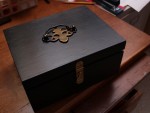 Let it be known that in the spring of the year 2016, MF3D Folio B was merged into Folio A. It came close to happening in 2008, but we got eight more years out of ‘er and it was a good run. I’ve built a new, larger box to house our combined works.
Let it be known that in the spring of the year 2016, MF3D Folio B was merged into Folio A. It came close to happening in 2008, but we got eight more years out of ‘er and it was a good run. I’ve built a new, larger box to house our combined works.
Some images from the last round of B were moved into A. These were re-labeled as such on these pages and are included in the Folio A category. A handful of images from the last round of B were returned to the artist under separate cover. These remain listed here in under Folio B.
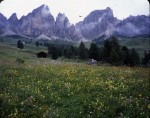 Location Alta Via Trail, 3 hrs N Venice
Location Alta Via Trail, 3 hrs N Venice
Technical Fuji GA645w (cha-cha no slide bar ), Fuji Provia F100
Comments In July of 2014 my wife and I trail ran and trekked the
Dolomites in the Italian Alps. There is a lot to see here: the classic
Dolomite peak craggy rock formations, the wild flowers that slowed down
just enough for me to take this stereo pair cha-cha, maybe not the
moving clouds in the bg.
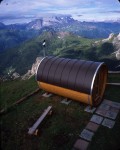 Location Alta Via Trail, 3 hrs N Venice
Location Alta Via Trail, 3 hrs N Venice
Technical Fuji GA645w (cha-cha no slide bar ), Fuji Provia F100
Comments In July of 2014 my wife and I trail ran and trekked the
Dolomites in the Italian Alps. This view is the famous sauna at the
Lagazuoi refugio that awaits you after a long trek to get there.
I wanted to dedicate my submission this year to David Lee, who was a great master of medium format 3d and who I was lucky enough to meet. His work has been an inspiration to me.
Thank you for allowing me to share my work. I have enjoyed yours on this round
Nik Sekhar
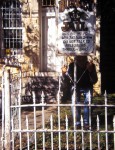 Taken in Burnet, Texas in 2014. This historic jail was built in 1884 of hand-hewn rock. It has an apartment for the sheriff who is also the jailer. On the second floor the county library was founded. The former jail is still being used by one of the county departments. The city of Burnet is nestled in the heart of the Texas Hill Country surrounded by rolling hills, lakes, beautiful geologic formations and historical sites. The historic square features buildings from as early as the 1880’s and offers a variety of unique shops and eateries. Drive in or take the Hill Country Flyer Historic Train (which is what we did) from Cedar Park, located on the edge of Austin. Watch the Burnet Gunfighter’s fight it out at the Old West Town on Saturday and Sunday. Taken with the TL120, available light handheld.
Taken in Burnet, Texas in 2014. This historic jail was built in 1884 of hand-hewn rock. It has an apartment for the sheriff who is also the jailer. On the second floor the county library was founded. The former jail is still being used by one of the county departments. The city of Burnet is nestled in the heart of the Texas Hill Country surrounded by rolling hills, lakes, beautiful geologic formations and historical sites. The historic square features buildings from as early as the 1880’s and offers a variety of unique shops and eateries. Drive in or take the Hill Country Flyer Historic Train (which is what we did) from Cedar Park, located on the edge of Austin. Watch the Burnet Gunfighter’s fight it out at the Old West Town on Saturday and Sunday. Taken with the TL120, available light handheld.
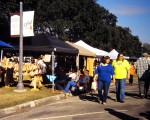 Goliad Market Days is an open air market which combines an arts and crafts fair, farmers market and community festival. Market Days are held to relive Goliad’s traditional role as a crossroads for commerce, beginning with the 1700s’ Spanish-colonial trade from Mexico to Nacogdoches. The tradition continued throughout the 19th century, as Goliad was included on the routes for oxcarts, freight wagons, and stagecoaches. Today, Goliad Market Days is one of the largest and most popular street markets in South Texas. Goliad is the third oldest municipality and is rich in Texas history. It is the County Seat of Goliad County, one of the oldest counties of Texas. First named Santa Dorotea by the Spaniards in the 16th century, its name was changed February 4, 1829 to Goliad. The name is an anagram derived from the last name of a Spanish missionary priest, Father Hidalgo.
Goliad Market Days is an open air market which combines an arts and crafts fair, farmers market and community festival. Market Days are held to relive Goliad’s traditional role as a crossroads for commerce, beginning with the 1700s’ Spanish-colonial trade from Mexico to Nacogdoches. The tradition continued throughout the 19th century, as Goliad was included on the routes for oxcarts, freight wagons, and stagecoaches. Today, Goliad Market Days is one of the largest and most popular street markets in South Texas. Goliad is the third oldest municipality and is rich in Texas history. It is the County Seat of Goliad County, one of the oldest counties of Texas. First named Santa Dorotea by the Spaniards in the 16th century, its name was changed February 4, 1829 to Goliad. The name is an anagram derived from the last name of a Spanish missionary priest, Father Hidalgo.
The Spaulding Meadows are popular all year round. These are not meadows with cultivated hay fields. These are meadows in the second sense of the word, being areas of grass and flowers near the treeline. In the winter, they are very popular ski destinations, but the snowfall was so scant this year that there was virtually no skiing at all. They will often have snow in them until May, but by February 2015, the snow was gone. The images in this set are from a pair of trips I made to try to capture the combination of snow-free meadows and low-angle light.
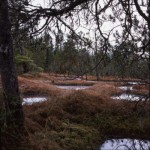 Spaulding Ponds
Spaulding PondsThe ponds and pools in the meadows were still solid enough to walk across, so it made for very easy access to all corners of this space. I nestled in under a couple of trees to try to capture the frosty glint on the branch tips. I provided a little bit of fill-flash in an attempt to brighten the gloom under the trees.
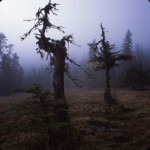 Two Towers
Two TowersDespite the level of the clouds, I think you can gauge the height of the sun. This was about noon, so you can see that the sun doesn’t get very high in Juneau in the winter. I think this image effectively contains infinity without containing a horizon. This is a very common condition in Southeast Alaska. The weather is very close and we are often hiking in the clouds at less than 1,000 of elevation. This image was made at about 800‘ with my TL120-55.
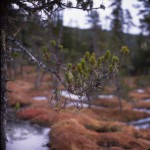 Spaulding Close Up
Spaulding Close UpWhile enjoying a cup of tea and taking in my surroundings, I found myself staring at a tree. My attention was drawn to a low-lone branch. And further drawn to the tufts of needles on a twig on that branch. And here it is. I would have liked to close in on a single tuft, but the TL120-1 can’t focus closely enough.